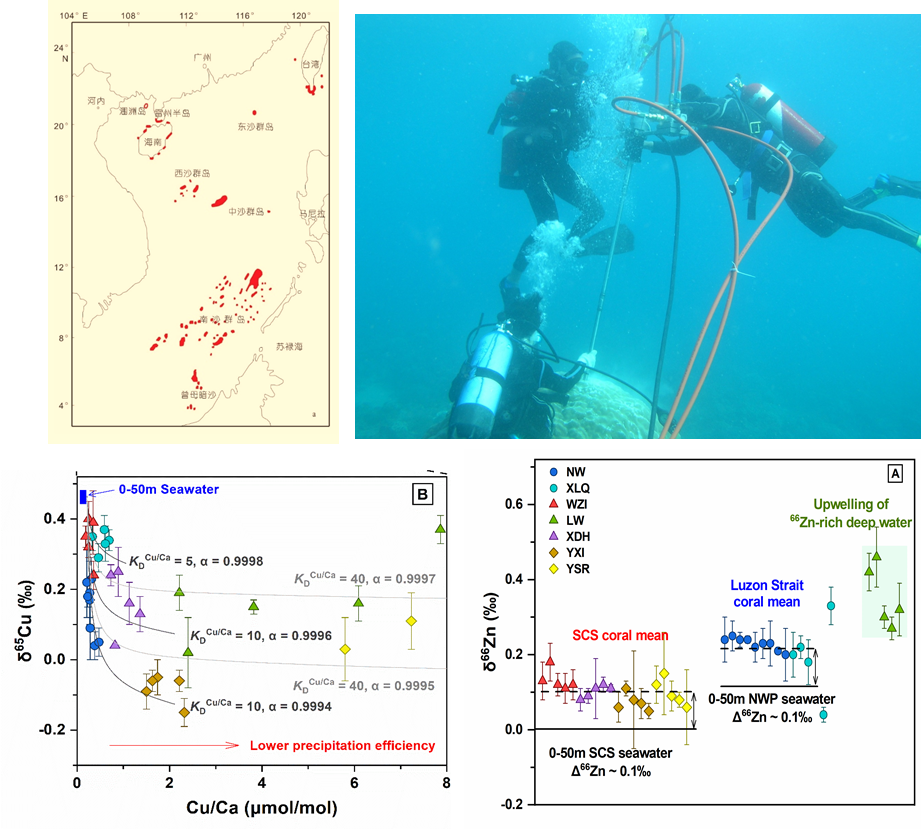Cu and Zn are essential micronutrients for marine primary producers and their isotopes are fractionated along certain trajectories during key biological and chemical processes in oceans. Recent studies find that Cu and Zn isotopic compositions in ancient marine carbonates have changed in parallel with several significant perturbations in geologic processes and Earth’s climate, highlighting their great potentials as proxies for rebuilding Earth’s environmental and life evolution. Understanding Cu and Zn isotopic fractionation in modern carbonate is prerequisite for their applications to geological past. Scleractinian corals (commonly called “hard” or “stony” corals, derived of aragonite), which live in shallow waters and are a major component of marine carbonates, are distributed widely throughout the modern and past oceans. Studies of these coral species from different locations and marine environments would provide thus better constraints on Cu and Zn isotope fractionation between marine carbonates and seawaters.
Recently, research groups of Prof. Yi Liu and Prof. Jiubin Chen from School of Earth System Science, Tianjin University investigated annual Cu and Zn isotopic compositions in modern Porites corals from the South China Sea (SCS), and the Luzon Strait adjacent to northwestern Pacific, aiming to reveal Cu and Zn isotope fractionation during their transfer from dissolved seawater phase into the solid carbonate phase of shallow water coral. The data is a valuable contribution towards improving the constraints on both Cu and Zn isotope biogeochemical cycling in the ocean and in carbonate archives that have potential applications in palaeoceanography and palaeo-environmental reconstructions. The results have been published in Geochimica et Cosmochimica Acta.
This work found that the aragonitic skeletons of corals are enriched in light Cu but heavy Zn isotopes relative to surface seawaters. The coral δ65Cu exhibits significant inter- and intra-colony variations, which are most likely controlled by Rayleigh-type fractionation in the calcifying fluids of corals rather than by changes in environmental factors or seawater δ65Cu. Thus, δ65Cu in ancient carbonates may not be a direct record of Cu isotope compositions in coeval seawaters. In contrast, coral δ66Zn shows insignificant temporal variation, and the Zn isotope fractionation between individual corals and seawaters are relatively small and constant (0.10 ± 0.05‰, n = 33, 2SD). This limited Zn isotope fractionation is much lower than that determined during inorganic precipitation of calcite, which is likely due to pH up-regulation by the coral that changes aqueous Zn speciation, and preferential organic complexation of the heavy Zn isotopes in the calcifying fluids. Therefore, Porites corals are promising archives for tracking historical changes of surface seawater δ66Zn. The new datasets of reef carbonates, particularly the coral δ65Cu values which are measured for the first time, could provide a better constrain on marine Cu and Zn geochemistry and their modern oceanic mass and isotope budgets.

This research was supported by the National Science Foundation of China (41922019, 41961144028, 41625012).
Article information: Ting Zhang, Ruoyu Sun, Yi Liu*, Lu Chen, Wang Zheng, Cong-Qiang Liu, Jiubin Chen. Copper and Zinc isotope signatures in scleratinian corals: implications for Cu and Zn cycling in modern and ancient ocean. Geochimica et Cosmochimica Acta. https://doi.org/10.1016/j.gca.2021.10.014